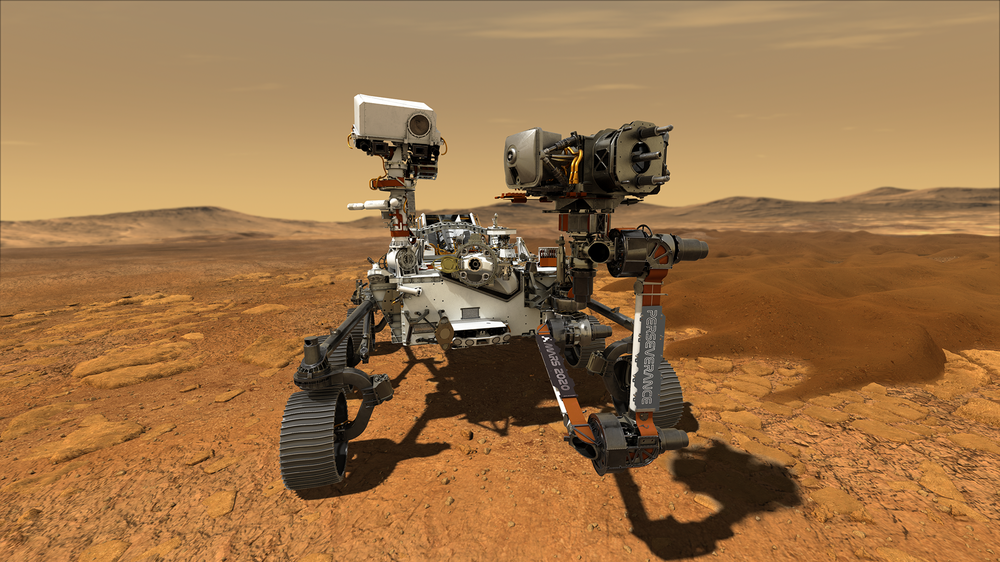Mars 2020 and ExoMars
NASA’s Mars 2020 Perseverance rover landed in Jezero Crater on 18 February 2021. Rosalind Franklin, previously known as ExoMars 2022, was scheduled to launch in 2022. It was delayed to 2028, after ESA severed ties with Roscosmos in March 2022. After reconfiguration to replace the Russian mission elements, the mission is now expected to be launched in 2028, together with NASA as a new partner.
Both missions aim to investigate whether life has ever existed on Mars. While the Rosalind Franklin rover will analyse samples from the Martian subsurface onboard with its suite of analytical instruments, Perseverance is collecting a suite of samples that will eventually be returned to Earth.
Perseverance is operating in Jezero Crater, a 45 km wide crater formed around early Hesperian time on the western edge of Isidis Planitia. Jezero shows evidence of water inflow, forming a crater lake including a marked delta deposit. Flowing surface water combined with spectral detection of clay minerals and carbonates has made Jezero a prime target in the search for life. In its first Martian year (687 Earth days), Perseverance has driven 14 kilometres, completed its exploration of the Jezero crater floor, and started 2023 the exploration of the delta deposits. Of the 38 sample collection tubes Perseverance brought to Mars, the rover has already collected (as of august 2023) 20 samples of Martian rock and atmosphere and deposited them on the surface in the first ever sample depot on another world. DLR contributes to the mission with two Co-I’s in the Mastcam-Z team, and collaborators in the MEDA team.
The ExoMars Trace Gas Orbiter was launched in 2016 and commenced its routine operations in April 2018. The second mission in the programme will deliver a European rover, Rosalind Franklin, to a landing site at Oxia Planum – the oldest location on Mars investigated so far. The rover with its drill is the sole mission currently being developed that is able to access and investigate subsurface samples. Oxia Planum sediments have the potential to record unique information regarding early, water-rich Mars environments, prebiotic chemistry, and possibly life. The rover carries a Panoramic Camera (PanCam), which includes a DLR-provided High Resolution Camera (HRC) for close up investigations. DLR is represented with the PanCam Co-PI and Co-Is in several payload teams.
Besides scientific data analyses, Co-I responsibilities for both missions include the definition of rover science operations procedures, camera observation sequences, active roles in the rover operations team, and provision of high precision maps including digital terrain models.
Hardware Participation of the DLR Institute of Planetary Research at ExoMars-Rover
- PanCam-HRC (Panoramic Camera High Resolution Camera)
Co-PI: Nicole Schmitz
Scientific Participation of the DLR Institute of Planetary Research at ExoMars Trace Gas Orbiter
- CaSSIS (Colour and Stereo Surface Imaging System)
- ACS (Atmospheric Chemistry Suite)
Scientific Participation of the DLR Institute of Planetary Research at ExoMars-Rover
- PanCam (Panoramic Camera)
- WISDOM (Water Ice Subsurface Deposit Observation on Mars)
- CLUPI (Close-UP Imager)
- Ma_MISS (Mars Multispectral Imager for Subsurface Studies)
Further DLR ExoMars Participation
Raumflugbetrieb und Astronautentraining: Microgravity User Support Center
Scientific Participation of the DLR Institute of Planetary Research at Mars 2020
- Mastcam-Z (Mast Zoom Camera)
- MEDA (Mars Environmental Dynamics Analyzer)

